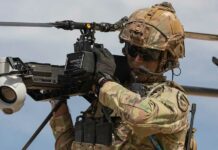L-3 Communications completed flight tests of a new IP-enabled, wideband Multi-Platform Common Data Link (MP-CDL) demonstrating the capability to sustain high capacity airborne networking. The test involved multiple missions flown by two Big Crow NKC-135 aircraft, establishing up to 274 Mbps datalinks over distances of 300 nautical miles (km). Simultaneous video transmission to man-packable ROVER III terminal validated the system’s ability to provide real-time, full-motion video through the net-centric MP-CDL terminal directly to warfighters on the ground.
The demonstration established datalinks between the two aircraft and from the aircraft to the Global Information Grid (GIG), the Internet, and the public switched telephone network using the Department of Defense’s (DoD) Network CDL, Standard CDL, and MP-CDL is a production-ready data link delivering advanced communications capabilities including automatic self-healing network formation, IP routing, adaptive transmit power and data rate selection, automatic signal acquisition and jam resistance.
Network applications demonstrated simultaneously on Big Crow through the MP-CDL terminals included multiple simultaneous high bandwidth video streams, video teleconferencing, high-definition video, Voice over Internet Protocol (VoIP) with access to the public switched telephone network and Internet access to the World Wide Web and e-mail.
The Big Crow flights passed high-bandwidth data from one aircraft to the other, automatically routing traffic through to the ground site and distant networks when required. Standard Ethernet interfaces allowed personal computers onboard the aircraft to communicate through the system to the Internet at high data rates, with a variety of user application software.
Additionally, L-3 Integrated Systems (L-3 IS) demonstrated their third generation EV-3 Office In The Sky application suite with the MP-CDL system and utilized the high bandwidth, net-centric data link capability to provide an eight-way real time Video Teleconferencing (VTC) connecting the two airborne platforms and multiple ground locations, including Washington, DC. Their integrated VoIP was also used to provide connectivity with the public telephone networks.



















